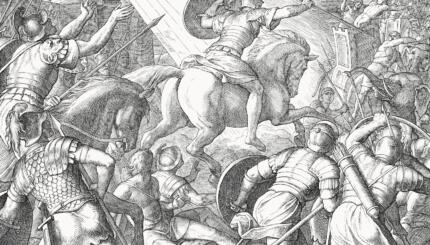The Joseph story is the most sustained narrative in the book of Genesis. In this week’s Torah portion, the drama of Joseph’s concealment and the increasingly precarious plight of his brothers reaches a heightened pitch.
Joseph, having risen to become viceroy of Egypt, confronts his brothers who have traveled to Egypt to find food during a famine. The brothers don’t recognize Joseph, but Joseph knows who they are and enters into a strange negotiation with them, asking about the well-being of their father Jacob and Benjamin, Jacob’s youngest son. Eventually, Judah, the brother who had facilitated the sale of Joseph into slavery and saved him from death in the pit where the other brothers had thrown him, steps forward and offers to remain a slave in Egypt and allow Benjamin, who Joseph had falsely accused of theft, to return to Jacob.
There is a tradition that both Joseph and Judah represent messianic figures, albeit of different sorts. Joseph bears the lineage of messiah son of Joseph, a military leader who fights the messianic wars before the messianic era, while Judah represents messiah son of David, the true messiah who will redeem Israel. Joseph is a worldy figure, Judah a more spiritual one.
In Mei Ha-Shiloah, the Hasidic master Mordechai Joseph Leiner of Izbica famously created a typology from this narrative that, in a sense, exposes a tension lying beneath the whole of Jewish tradition. In Leiner’s view, Joseph views the world from within the confines of the law while Judah views the world from the perspective of the divine. Joseph represents fidelity to tradition and Judah the pull toward experience. Or as Leiner’s grandson, Gershon Henoch Leiner of Radzin, put it: “Joseph is the zaddik [righteous person] who sees everything with clarity and seeks to serve God as a servant. Judah on the other hand, gives himself completely over to God such that even the law of free-will is naught for him.” Joseph lives in the world as it is, Judah lives in the world as it should be.
With your help, My Jewish Learning can provide endless opportunities for learning, connection and discovery.
This typology pits convention against radicalism, conservatism against innovation, the is versus the ought. For Hasidic thinkers, true devotion must contain both Joseph’s caution and Judah’s courage. But of course, Judah is really the dominant Hasidic model. Hasidism set out to challenge the legalism of the rabbinic Judaism of its time, which viewed Judaism as totally subsumed within the legal (halakhic) system. In place of this focus on law and Torah study, Hasidism emphasized the achievement of devekut, communion with the divine through devotional practice and, at times, ecstatic worship.
Religious communities are often constructed around similar tensions, between the normative and the experimental, the cautious and the audacious. Early Hasidism was an illustration of that tension. It offered a sharp critique of the formalism of the law and yet also maintained adherence to the law.
At a certain time, probably in the middle decades of the 19th century, Hasidism’s early radicalism gave way to a return to a more conventional style of practice and belief. Hasidism stepped back from the threat of a rupture that would have pushed it outside the boundaries of normative Judaism. In our context, it buried Judah under the cloak of Joseph.
At about the same time, Jews who had abandoned the Joseph model of strict halakhic observance under the influence of the Jewish Enlightenment (Haskalah) began to look back at Hasidism as a resource for a new Judaism liberated from the confines of Joseph. They allowed Judah’s perspective to breathe, free of his confining brother. Thus was born neo-Hasidism, initially a movement of writers and artists who used Hasidism as a resource for their creative endeavors. Later adherents in postwar America, some of them inspired by the New Age movement, sought to create a non-Orthodox Judaism informed by Hasidic spirituality.
Neo-Hasidism may have chosen Judah over Joseph, but it still largely viewed itself within the Joseph-Judah paradigm. That is, neo-Hasidism saw Joseph for what he was, the exemplar of legal formalism, and rejected (or de-emphasized) him. But in doing so, it remained haunted by the specter of Joseph.
The step that moves neo-Hasidism out of Joseph’s shadow might be called post-Hasidism. This new phase could rebuild a Judah Judaism no longer haunted by Joseph, but which doesn’t fully abandon Joseph either. Rather, post-Hasidism reconstructs Joseph in its own image, abandoning the confines of halakha while retaining a belief in the centrality of practice and ritual as the core of the Jewish experience. (This is sometimes called post-halakha.) Joseph remains, as he must, but in this phase he does not prevent the unfolding of God’s newness in the world or trap us in a reality that is no longer operative. Joseph never disappears, he is just remade in Judah’s image.
This kind of renewal of the old in line with a new understanding of the world is not only necessary, but desirable — even holy. This is the process that Rabbi Mordecai Kaplan in the 1930s called reconstruction and Rabbi Zalman Schachter-Shalomi several decades later called renewal.
Joseph and Judah embody the tension between normativity and innovation, conservation and revolution, between the real and the ideal. Early Hasidism offered us one model of dealing with that tension, later Hasidism offered another, and neo-Hasidism still another. Perhaps now those who have inherited the neo have to look toward the post. A new world awaits a new Torah. Or as the Midrash amends the verse from Isaiah 51:4, “A new Torah will go out from Me.” The inheritors of Judah are our light, the remnants of Joseph our strength.
This article initially appeared in My Jewish Learning’s Shabbat newsletter Recharge on Dec. 11, 2021. To sign up to receive Recharge each week in your inbox, click here.



